Science & technology reaching out, benefitting people
India’s Science, Technology and Innovation Policy focuses our attention on faster, sustainable and inclusive development of the people. In pursuance of this, the DST is supporting scientific and technological developments to make lives of people better. This support has translated to numerous sustainable technologies helping their lives and livelihoods through clean energy, water, air as well agricultural devices for increase farmer’s income and ease their daily toil and so on. Social enterprises play a crucial role in implementing these technologies and in many cases even developing them, Science day brings us the occasion to celebrate some of them.
Surya Jyoti - Micro Solar Dome
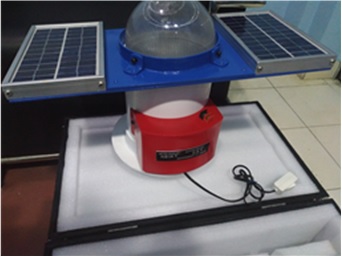
Surya Jyoti is a unique low cost device that captures day light and concentrate the same inside a dark room, particularly in urban slum or rural areas which lack electricity supply. A lighting device based on active and passive solar technique, it is suitable to install in any type of roof (Asbestos, Galvanized corrugated iron Sheet, Mud tiles or concrete), s. It brings safe and hygienic lighting solution for urban and rural poor, has zero CO2 emission and provides continuous 16-hour light in a day and night. It is easy to fabricate, fix and maintain, has high potential of employment generation.
Solar Water and Space Heating Panels
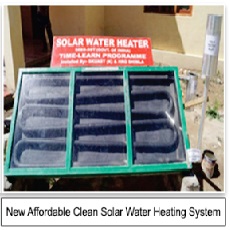
Rural areas in Indian Himalayan Mountains are facing grave energy crisis and high dependence on fuel wood due to cold climate poses a potential threat to the ecology, health of household inmates and involve women drudgery in fuel wood and dung collection. Himalayan Research Groupo (HRG), Shimla, a Core Support Group of SEED, DST designed and fabricated a low cost solar water and space heating panel of locally available material by the local artisan (carpenter). The Solar panels are fabricated on wood frame, window glass available in local households with innovative carbon paint to absorb maximum sun energy for water and space heating. The technology takes advantage of the fact that in high altitude sun is brighter and intense in winter than plains and at the same time at altitude boiling point of water is low. Water heating panel provide 100-120 liters water per day at maximum temp of 90 degree Celsius in a sunny day even in winter months. Space heating panel blow at a maximum of 65 degree centigrade and improve 12-15 degree centigrade temp of living space providing thermal comfort to the mountain people.
Rice de-husking machine
Rice De-husking machine developed by Vigyan Ashram, Pune, a Core Support Group of SEED, DST, helps to reduce the manual effort to separate husk from the rice. It can process 8 to 10 k.g. rice in an hour and is useful for brown rice production unit for domestic level manufacturing. . Rice can be processed multiple times as per the quality required. It is easy to operate and work on single phase connection. It has Low power consumption maintaining cost and is Useful for rice farmers, rural youth and women’s self-help groups
Shallow emitter silicon solar cell and modules process technology
Lightly doped emitter by optimizing various process steps using new front metal contact pastes & shallow emitter adopting standard manufacturing steps without any additional process steps.
Best cell efficiency of 19.24% achieved with typical efficiency distribution of 19% for a few batches of solar cells.
Solar cell efficiency achieved commercially at the commencement of project by BHEL was 17%. That was raised to 18.75% in commercial manufacturing facility of Electronic Division (EDN), BHEL at Bangalore.
Hybrid Solar-Biomass Power Plant

These are renewable energy based small scale distributed energy plants integrating solar & biomass for a 24x7 operation with a capability to dispatch power into the local grid for export of power. The pilot scale facility at 200 kW which can be scaled-up to 3 MW. It operates with Solar Parabolic Trough technology direct steam generation, organic rankine cycle and provides power evacuation to existing Grid at Shive Village
JalKalp Water Filter
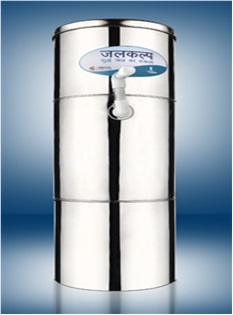
Jalkalp is an easy, inexpensive, sustainable and effective technique to treat water. The filter is capable of removing biological impurities from water such as bacteria, protozoa, viruses, and parasites, etc. besides turbidity, iron, arsenic. It is easy to operate and maintain with no periodic maintenance cost and filters upto 0.6 litres per minute without any energy input as it works under gravity. It results in 100% removal of coliforms, removal of iron up to 10 PPM, arsenic up to 265 PPB, and cleares turbidity up to 50 NTU
Passive Ambient Air Purifier System (PAARS)
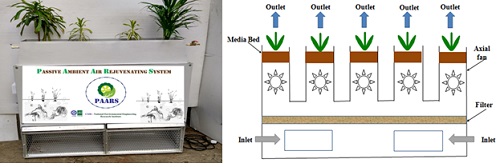
The device basically works on the principle of passive removal of pollutants and wind generation for dilution of air pollutant. Air is passed through appropriate size filters where particulates are removed. Air free of particulates is then passed through media with plant which further helps in reducing gaseous pollutants in the air. Air generators can help in augmenting wind turbulence in near zone so that dilution takes place. At the outlet of the device, the air has some residual velocity. This velocity of air creates turbulence in the atmosphere which thereby helps bringing down the pollutant concentrations by the method of dispersion.
WAYU Design 1 & 2
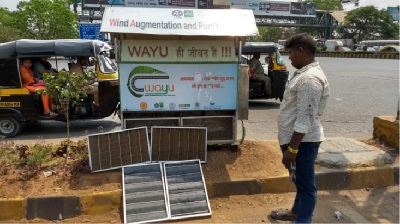
National Environmental Engineering Research Institute (NEERI), IIT Bombay, and Maharashtra Pollution Control Board (MPCB) have come together to address the issue of air pollution at traffic junctions. A device known as ‘Wind Augmentation and purifYing Unit (WAYU)’ to improve the air quality at urban intersections has been developed and integrated in a way that it can work with solar power.
This device works basically on two principles. Wind generation for dilution of air pollutants and Active Pollutants removal. It uses low speed wind generators, appropriate size filters for long operation cycle with reasonable efficiency and has an oxidizer unit for removal of Carbon-monoxide and Hydrocarbons including VOCs. The air is passed through the filters where the particulates are removed. The air generators without filter can help in augmenting wind turbulence in near zone so that dilution takes place (like in nature). In the next level where active pollutants are removed, filters and thermal system are used. The air is heated inside the specially designed with appropriate surface and retention time, within the thermal oxidisers where the carbon monoxide, hydrocarbons, VOCs get converted to carbon dioxide. At the outlet of the device, the discharged air has some exit velocity. This velocity of air creates air mixing and turbulence in the atmosphere which thereby helps bringing down the pollutant concentrations by the method of dispersion.
In the second improved version a photo catalytic chamber is used consisting of of 3 UV Lamps and activated carbon boxes arranged in layers holding TiO2 coated activated Carbon and perfectly shaped to allow maximum illumination of each and every particle with TiO2.






























